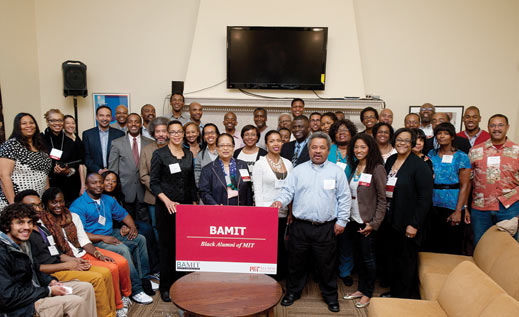Benefiting from Affinity Groups, Both On and Off Campus
Uttara Marti ’03, MEng ’05, one of 3,000 members of the Association of MIT Alumnae (AMITA), never gave much thought to becoming involved with AMITA while on campus—even though she was one of few women in Course 6.

After moving back to New York City, though, Marti soon found out what great opportunities could arise from building relationships with fellow alumnae.
“The AMITA events in New York have been a great, informal way to meet alumnae and hear about people who became successful in their fields or switched careers,” she says.
Thanks to a contact she made at one event at the Metropolitan Museum of Art, Marti started having regular lunches with a fellow alumna who became a mentor. At another event, she met another young alumna who had just enrolled at business school. Though she had never considered it herself, Marti enrolled a few months later; now she is a vice president at a banking advisory firm in New York.
AMITA, one of 10 MIT affinity groups based on cultures or interests, is about far more than networking. The group sponsors an academic award for graduating seniors each year and organizes events for current students. At the AMITA annual meeting in June, for instance, MIT chancellor Cynthia Barnhart, SM ’86, PhD ’88, told her story of becoming MIT’s most senior academic officer but also addressed a recent topic of campus concern.
“Barnhart spoke about what actions MIT is taking to decrease sexual assault and misconduct,” AMITA president Dorothy Curtis ’73 says. “This is not a fun topic, but one that is important to AMITA, and we fully support the chancellor in addressing this issue.”
Joining an affinity group (by completing a form on the alumni website) can be a way to benefit other people, too.
Alumni who join one of the gender- and race-related affinity groups can have a huge impact on prospective students, says Moana Bentin, associate director for affinity communities. “Seeing another young woman or black student or gay or bisexual alum who graduated, feels supported by the Institute, and is excelling in their role is invaluable,” says Bentin, “and the likeliness of ‘impostor syndrome’ drops exponentially.”
Besides AMITA, MIT’s affinity groups include the Alumni Association of the Center for Real Estate; Black Alumni of MIT; Bisexual, Gay, Lesbian, and Transgender Alumni of MIT; Latino/a Alumni/ae of MIT; the MIT Arab Alumni Association; the MIT Crew Alumni Association; the MIT Military Alumni/ae Association; the MIT Media Lab Alumni Association; and the MIT South Asian Alumni Association.
Keep Reading
Most Popular
Large language models can do jaw-dropping things. But nobody knows exactly why.
And that's a problem. Figuring it out is one of the biggest scientific puzzles of our time and a crucial step towards controlling more powerful future models.
How scientists traced a mysterious covid case back to six toilets
When wastewater surveillance turns into a hunt for a single infected individual, the ethics get tricky.
The problem with plug-in hybrids? Their drivers.
Plug-in hybrids are often sold as a transition to EVs, but new data from Europe shows we’re still underestimating the emissions they produce.
Google DeepMind’s new generative model makes Super Mario–like games from scratch
Genie learns how to control games by watching hours and hours of video. It could help train next-gen robots too.
Stay connected
Get the latest updates from
MIT Technology Review
Discover special offers, top stories, upcoming events, and more.